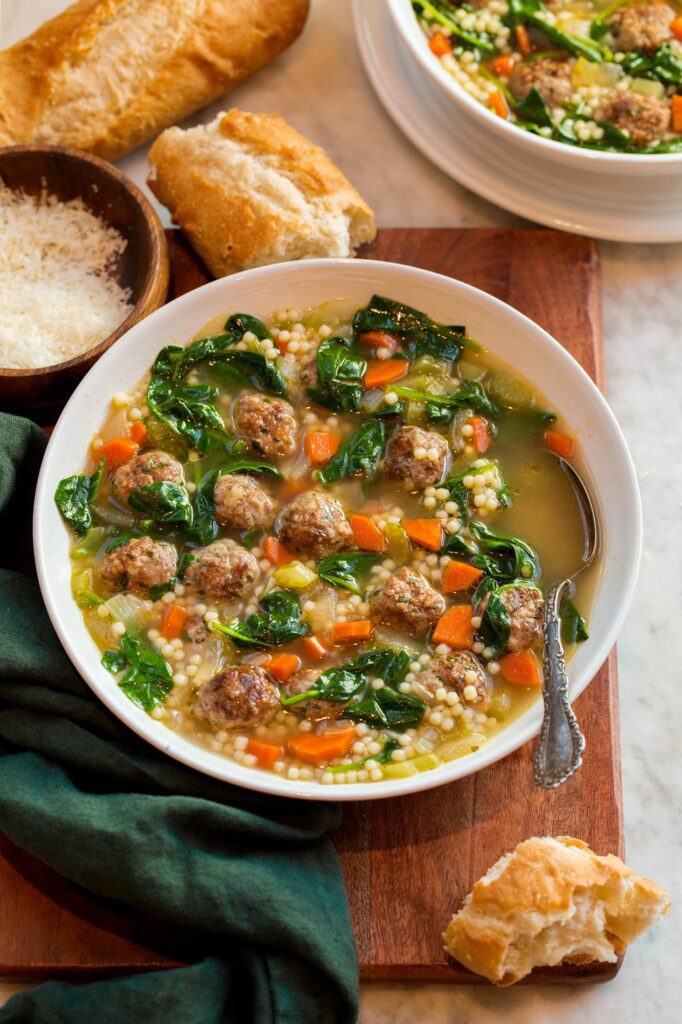Italian Wedding Soup is a delicious recipe that combines amazing flavors and textures.
Italian Wedding Soup is a beloved classic that belies its name—it’s not actually served at weddings, but rather represents the “marriage” of flavors between the meatballs, greens, and broth. This comforting soup has been warming hearts and homes for generations, offering a perfect balance of protein, vegetables, and carbohydrates in one satisfying bowl. The tiny meatballs, delicate pasta, and vibrant greens create textural harmony, while the rich broth brings everything together with savory depth.
The magic of this soup lies in its simplicity and perfection of proportion. The small meatballs remain tender and flavorful without overwhelming the broth. The pasta adds substance while absorbing the delicious flavors. The greens provide freshness and color contrast while contributing nutritional value. Every component plays its role perfectly, creating a soup that feels both light and substantial, comforting and revitalizing.
The History and Misconception
Despite its name, Italian Wedding Soup (minestra maritata in Italian) has nothing to do with actual wedding ceremonies. The name comes from the Italian phrase “minestra maritata,” which translates to “married soup”—referring to the marriage of flavors between the ingredients, particularly the meat and greens. This mistranslation has led to the common misconception that the soup is served at weddings.

The soup actually has humble origins in the cuisine of Naples and surrounding regions, where it was a way to use inexpensive ingredients to create a nutritious, satisfying meal. The combination of meat and bitter greens reflects the Italian culinary principle of balancing rich and lean, sweet and bitter elements. Immigrants brought variations of this soup to America, where it became popular in Italian-American communities before entering the mainstream.
The Science of Flavor Development
The depth of flavor in Italian Wedding Soup comes from several culinary techniques that create complexity. The initial sauté of onions, carrots, and celery (soffritto) provides a flavor foundation through caramelization and Maillard reactions. The vegetables’ cell walls break down during cooking, releasing sugars and amino acids that create savory depth.
The meatballs contribute flavor through multiple mechanisms: the Maillard reaction during cooking creates roasted, nutty notes; the fat from the meat emulsifies into the broth, carrying fat-soluble flavor compounds; and the proteins break down into amino acids that enhance umami perception.

The pasta starch thickens the broth slightly and helps suspend fat droplets, creating a richer mouthfeel. The greens provide sulfur compounds that offer sharp contrast to the richness, while the Parmesan cheese adds glutamates that enhance overall savoriness.
Ingredient Selection Guide
Meat: Traditional recipes use combination of pork, beef, and veal, but chicken or turkey work well for lighter version. Choose meat with some fat content (15-20%) for moist meatballs.
Greens: Escarole is traditional, but spinach works well and is more readily available. Other greens like kale, chard, or mustard greens can be used but will change flavor profile.

Broth: Quality chicken broth is essential as it forms the soup base. Homemade is ideal, but good quality store-bought works. For richer flavor, use combination of chicken and beef broth.
Pasta: Small shapes like acini di pepe, orzo, or pastina work best. Cook separately if making ahead to prevent becoming mushy.
Breadcrumbs: Fresh breadcrumbs create tender meatballs. Panko can be used for lighter texture. For gluten-free, use gluten-free breadcrumbs or almond flour.

Cheese: Freshly grated Parmesan or Pecorino Romano provides best flavor. pre-grated cheese contains anti-caking agents that can affect melting.
Technique Mastery
Meatball making: Mix ingredients gently until just combined – overmixing creates tough meatballs. Keep hands wet when forming to prevent sticking. Make small, uniform size for even cooking.
Soffritto preparation: Cook onions, carrots, and celery slowly until softened but not browned. This gentle cooking develops sweetness without bitterness.
Broth development: Simmer, don’t boil, after adding meatballs to prevent them from breaking apart. Skim any foam that rises to the surface for clearer broth.
Pasta cooking: Add pasta according to package directions, considering it will continue to cook slightly in hot broth. For meal prep, cook separately and add when serving.
Greens addition: Add greens at the end to preserve color and nutrients. They will wilt quickly in the hot broth.
Flavor Variations
While the classic version is perfect, consider these variations:
Different meats: Use combination of pork, beef, and veal for traditional flavor. Lamb meatballs add richness.
Alternative greens: Escarole provides slight bitterness that balances richness. Kale offers more texture. Arugula adds peppery note.
Broth enhancements: Add Parmesan rind while simmering for extra umami. Lemon zest at the end adds brightness.
Herb variations: Add fresh basil, oregano, or thyme for different herbal notes.
Spice level: Add red pepper flakes for subtle heat.
Meal Prep Strategies
This soup is excellent for make-ahead meals:
Component prep: Make meatballs ahead and freeze raw or cooked. Chop vegetables in advance.
Full make-ahead: Prepare soup without pasta and freeze for up to 3 months. Add pasta when reheating.
Portioning: Divide into individual containers for easy lunches or dinners.
Freezing: Freeze in portion-sized containers. Thaw in refrigerator before reheating.
Reheating: Reheat gently on stove or in microwave. Add fresh greens if they’ve become overcooked.
Dietary Adaptations
This soup adapts well to various dietary needs:
Gluten-free: Use gluten-free breadcrumbs and pasta. Rice or quinoa can substitute pasta.
Dairy-free: Omit cheese from meatballs and garnish. Nutritional yeast can provide cheesy flavor.
Lower carb: Omit pasta or use low-carb alternatives like zucchini noodles or cauliflower rice.
Vegetarian: Use vegetable broth and meatless meatballs made from beans or mushrooms.
Egg-free: Omit egg from meatballs and use alternative binder like mashed potato or flax egg.
Serving Suggestions
Complete your meal with these accompaniments:
Bread: Crusty Italian bread or breadsticks for dipping.
Salad: Simple green salad with vinaigrette provides fresh contrast.
Sandwiches: Gr cheese sandwich makes satisfying meal.
Wine: Light white wine like Pinot Grigio or light red like Chianti.
Extra garnishes: Additional Parmesan, red pepper flakes, or fresh herbs at table.
Cultural Significance
Italian Wedding Soup represents the Italian-American culinary tradition that adapted Old World recipes to New World ingredients and tastes. It exemplifies the Italian approach of creating extraordinary food from ordinary ingredients through technique and understanding of flavor balance.
The soup also represents the immigrant experience of preserving culinary heritage while adapting to new environments. Recipes like this were often shared within communities and passed through generations, becoming comfort food that connected people to their heritage while nourishing them in their new home.
Today, Italian Wedding Soup has transcended its ethnic origins to become a beloved dish across cultures, appreciated for its perfect balance of flavors, textures, and nutrition.
Final Thoughts
Italian Wedding Soup embodies the principles of good cooking: balance, technique, and quality ingredients. Its seemingly simple combination of elements creates something greater than the sum of its parts—a satisfying, nourishing meal that comforts both body and spirit.
As you master this recipe, you’ll develop fundamental soup-making skills that apply to countless other dishes: building flavor foundations, creating tender meatballs, and balancing components. These skills will make you a more confident cook capable of creating nourishing meals for yourself and your loved ones.
Whether you’re making this soup for a weeknight family dinner or for someone who needs comfort, it delivers satisfaction on every level. It’s the kind of recipe that becomes part of your personal culinary tradition, passed down and adapted through generations—a true marriage of technique, ingredients, and care.

Italian Wedding Soup
Ingredients
Method
- Combine meatball ingredients in bowl
- Form into small (1/2-inch) meatballs
- Place on baking sheet and refrigerate while preparing soup
- Heat oil in large pot over medium heat
- Add onion, carrots, and celery, cook until softened (5-7 minutes)
- Add garlic, cook until fragrant (30 seconds)
- Add broth, bring to simmer
- Carefully add meatballs to soup
- Simmer until meatballs are cooked through (10-12 minutes)
- Add pasta, cook until al dente (8-10 minutes)
- Stir in spinach until wilted
- Season with salt and pepper
- Serve garnished with Parmesan and parsley


